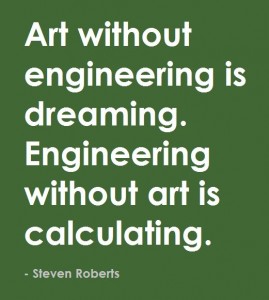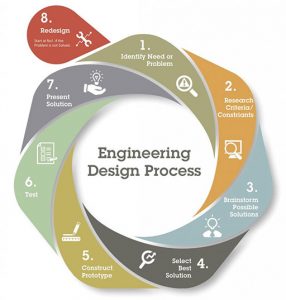“Can engineers design? Social science easily proves they cannot”. This is the first line of Bauke Steenhuisen’s essay in the independent university magazine Delta of TU Delft March 2017. In his essay he questions design and design education. Bauke is an assistant professor at the Faculty of Technology, Policy & Management and wrote the essay at the invitation of the TU Network Design Education.
Let me begin to say that I have been a design engineer all my life, so the first line of his essay sounds quite provocative to me. I have been designing satellites, advanced space instruments, satellite orbits, engineering curricula, workshops, street theatre festivals, and more. I have always seen design as a result and as a process that takes place in the contexts with plenty of unknowns, dynamics and disagreements. No need to say I come from a planet with an engineering society: on my planet the inhabitants believe that design is central to engineering: Design and engineering live hand in hand.
Two tribes of designers
In Bauke’s classification I would belong to the positivist tribe of design engineers at TU Delft. This tribe defines designing as a systematic approach to generate and select alternatives based on a set of requirements. This tribe lacks real-world validity, Bauke says. There exists a second tribe, he says, the postmoderns. They see design as an art or reflective creativity and refer design to virtually anything.
I am glad that both tribes live on the same planet where I live. The balance of engineering design and aesthetics is a core question when looking at design from different angles. A product won’t succeed without functionality and performance, but a customer won’t buy it without any attraction. Good looks, ease of use and solid performance are key assets of any design of whatever product or system.
Is STEM missing an A?
 Will the stereotypes of boring, serious engineers and whimsical, eccentric artists fall by the wayside? I don’t think so. I see many opportunities to enhance the appreciation for the “opposite” side, and to recognize that neither has such limited set of skills or interests as popular opinions may indicate. A merging of art and analysis on both sides could help make this two-way thinking about design less of a competition and more of an opportunity to broaden student achievement. The creative thinking and chaotic approaches of artists could be enriching for the rational thinking and structured project engineering approaches of the engineers, and vice versa. The whole discussion leaves the question of whether STEM is maybe missing an A. Science, technology, engineering, art and math, or STEAM, would have art and design integrated in the learning of the traditional STEM disciplines. I guess the resulting interdisciplinary thinking and the confluence of opposing views would help innovations of new technologies.
Will the stereotypes of boring, serious engineers and whimsical, eccentric artists fall by the wayside? I don’t think so. I see many opportunities to enhance the appreciation for the “opposite” side, and to recognize that neither has such limited set of skills or interests as popular opinions may indicate. A merging of art and analysis on both sides could help make this two-way thinking about design less of a competition and more of an opportunity to broaden student achievement. The creative thinking and chaotic approaches of artists could be enriching for the rational thinking and structured project engineering approaches of the engineers, and vice versa. The whole discussion leaves the question of whether STEM is maybe missing an A. Science, technology, engineering, art and math, or STEAM, would have art and design integrated in the learning of the traditional STEM disciplines. I guess the resulting interdisciplinary thinking and the confluence of opposing views would help innovations of new technologies.
Who are they who think we cannot design in a complex, wicked and unruly world?
If an engineer wants to design, he or she needs to have a list of requirements, understand how the world works and make choices in order to promise that their design will have certain desirable effects when implemented. These simple conditions are not at all trivial in the real world. “What if designers ask for a list of requirements but they don’t get one? What if the world keeps changing during and after the design process? What if designers disagree whether the world has changed or whether requirements should change? What if designers don’t know how the world works? What if designers cannot convince each other or the relevant decision-makers to make certain design choices? What if we simply don’t know who actually makes the design choices, even after the choices have been made?”
“The world is complex, wicked and unruly. Hence we cannot control, manage or design” (Bauke Steenhuisen)
“There are always plenty of unknowns, dynamics and disagreements in the game to compromise the opportunity to design”. And thus, Bauke concludes in his essay, nobody is able to design in the purest form, and so “the core of engineering is hollow, and design is a naïve and hyper-rational disillusion”.
These must be the words of somebody who lives on a different planet than I do, whose civilization is detached from engineering practice and apparently considers design as an exact science. Many design engineers will understand with me that designing in practice is far from being an exact science. That in itself does not justify any of the suggestions in the essay to stop teaching and practicing design skills in engineering curricula. I never heard such utter bullocks.
Because, learning how to deal with all the above if-questions, is not that exactly what design education should be all about? Designing is not only drawing, calculating, developing and inventing. It is a very social and creative activity instead, following a certain methodology like design thinking or systems engineering. And exactly that makes the learning how to design, as one of the key intended learning outcomes for most, if not all engineering programmes.
None of the four suggestions
Let’s get practical, and change design education in our curricula, Bauke says: “Stop offering design challenges in engineering education, teach educated engineering instead of design, teach design as something utopian, or teach engineering students not to design.”
None of these four suggestions to change design education gives me a single reason to believe that engineering graduates will master better engineering and design skills when we adopt any of these suggestions. Of course not! Designing is about adding value. Simply finding solutions for technical problems in isolation does not provide any useful value by itself. The value only arises when the technical solution is implemented and applied, so that customers and end-users can experience the benefits.

The Engineering Design Process (Source: blog Tom Jenkins)
Adopting any of the suggestions would mean that engineering students would no longer learn that mission complexity is growing faster than the ability to manage it. They would not learn to balance sometimes contradictory demands or understand that designs emerge from pieces and sub-assemblies that are fragile, difficult to manufacture and test and complex to operate and integrate. They would not get the insight that knowledge and experience are lost at project life cycle boundaries, which increases design risk and cost. And they would not learn how technical and programmatic aspects of engineering projects can be coupled to improve risk-based decision making. And they would not acquire the insight that design engineers have to integrate social, functional and physical demands to create valuable design solutions.
Passion and purpose
The essay forgets to address that millennial students look for purpose and authenticity in their study. They will not find them in the abstract theories or concepts but they will in immersive, integrated problem- and challenge-based learning around cases that are of personal and societal significance in the real world. Design challenges offer excellent opportunities to solve real-world problems and connect to the real world of student’s life and motivate holistic thinking. It is in these projects that students work passionately in interdisciplinary teams and find the purpose of all abstract theories and concepts we feed them in their study. It is in these projects they encounter many of the above iffy questions when they analyse the problem to be solved.
They will also learn that both the problems and the solutions co-evolve over time. If we would decide stop teaching and practicing how to manage that aspect, students will never succeed in solving complex problems in engineering practice because these are full with change and uncertainty. Our prospective design engineers have to learn how to systematically control these uncertainties and risks, and “do not simply stir in a soup of uncertainties and wait what comes out”. Design failures may happen, and these provide lessons that impact the practice. That does not mean that designing as such is an utopian skill, but reminds the professional designer and the student that designing is a human activity. Learning how to cope with failures and how to prevent them is crucial. It seems that the author of the essay never heard about the existence of Failure Mode Effects and Criticality Analysis (FMECA), and Reliability, Availability, Maintainability and Safety (RAMS) analysis in the practice of every day’s design work in engineering practice.
Epilogue
Design forms part of the core of engineering. Design has to remain grounded in the theoretical foundations of engineering education, that span the hard mathematics and physics, engineering sciences, and human and social sciences.
 Design education can only be questioned by those who have no clue whatsoever what engineering and design in practice is about. For these people, and many others who are interested in the practice of engineering and design, I recommend the book “The Making of an Expert Engineer” by James Trevelyan. It shows that engineering is much more than solving problems and design. In the daily practice of the professional engineer solving problems and designing solutions are living together. And the handling of the co-evolvement of problems and solutions is one of the key competences that engineering students need to learn in their study, now and in the future.
Design education can only be questioned by those who have no clue whatsoever what engineering and design in practice is about. For these people, and many others who are interested in the practice of engineering and design, I recommend the book “The Making of an Expert Engineer” by James Trevelyan. It shows that engineering is much more than solving problems and design. In the daily practice of the professional engineer solving problems and designing solutions are living together. And the handling of the co-evolvement of problems and solutions is one of the key competences that engineering students need to learn in their study, now and in the future.



